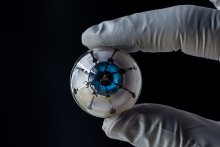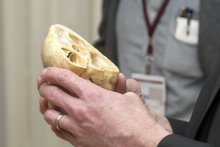News

Immigration to the United States changes a person’s microbiome
Posted
Researchers at the University of Minnesota have new evidence that the gut microbiota of immigrants and refugees rapidly Westernize after a person’s arrival in the United States.

University of Minnesota researchers have discovered how to slow aging process
Posted
In new research published today, University of Minnesota researchers have found a natural product, called Fisetin, can reduce the level of damaged cells in the body, which can slow the aging process. Chemistry Professor Edgar Arriaga played a key role in the research.

Researchers 3D print prototype for ‘bionic eye’
Posted
A team of researchers at the University of Minnesota have fully 3D printed an array of light receptors on a hemispherical surface. This discovery marks a significant step toward creating a “bionic eye.”

New 3D-printed device could help treat spinal cord injuries
Posted
Engineers and medical researchers at the University of Minnesota have teamed up to create a groundbreaking 3D-printed device that could someday help patients with long-term spinal cord injuries regain some function.

Professor Bischof named director of University's Institute for Engineering in Medicine
Posted
Distinguished McKnight University Professor John Bischof has been appointed for a three-year term as director of the University of Minnesota Institute for Engineering in Medicine (IEM). He has served as interim director during the past year.

First-ever study of triple gene combinations could help predict risk of disease
Posted
In the largest study of its kind, researchers at the University of Minnesota and University of Toronto have revealed a complex network of genes that work together. The research reveals genetic connections that can help develop new life-saving treatments to combat diseases such as cancer, heart disease, and diabetes.

New research outlines future for developing oral medicines that work more efficiently
Posted
Researchers at the University of Minnesota and The Dow Chemical Company have joined forces to tackle one of the biggest challenges in health care—how to get life-saving medicines to work faster and better with fewer side effects.

University of Minnesota hosts world's largest medical devices conference April 9-12
Posted
Medical device leaders from across the country in both industry and academia will converge at the University of Minnesota’s 17th annual Design of Medical Devices Conference. More than 1,300 people are expected to attend this year’s conference, making it the largest medical devices conference in the world.

Chad Myers: Exploring genetic connections in breast cancer
Posted
A University of Minnesota professor is using a computational model to analyze the correlation between breast cancer and genetic variants.

Efie Kokkoli: Tiny technology treats big disease
Posted
College of Science and Engineering researcher Efie Kokkoli is leading a team to engineer and evaluate materials that address brain tumors.
